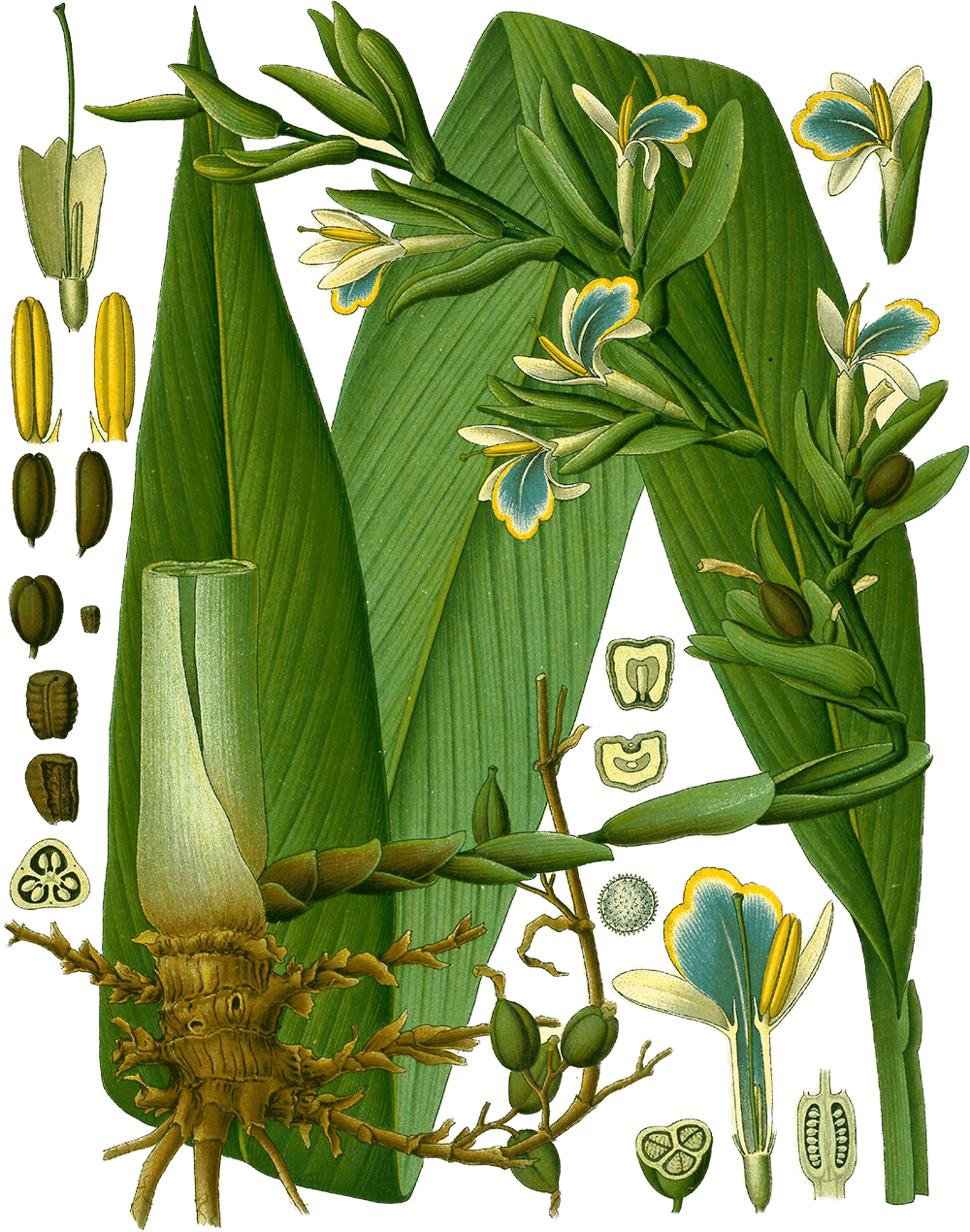Cardamom #

Illustration of Elettaria cardamomum (L.) Maton from Köhler's Medizinal-Pflanzen (1887)
Cardamom (Elettaria cardamomum (L.) Maton) is a culinary spice from the Zingiberaceae family,1 originating in the region(s) of India.2 It is used for its fruit (seed pods, capsules), primarily for desserts, coffees, curries. Its aroma is described as pungent, eucalyptus-like, with a heat index of 2.3
| English | Arabic | Chinese | Hungarian |
|---|---|---|---|
| cardamom | هال | 豆蔻 | kardamom |
Overview #
| id | cardamom |
|---|---|
| species name | Elettaria cardamomum (L.) Maton |
| family | Zingiberaceae |
| part used | fruit (seed pods, capsules) |
| macroarea | Asia |
| region of origin | India |
| cultivation | Guatemala; India; Sri Lanka; Tanzania; Papua New Guinea |
| color | green seed pods, brown seeds |
| botanical database | POWO |
Etymologies #
English cardamom ‘cardamom’, (via post-classical Latin cardimomum, a. 1398), ?ca. 1425 < later also from Old French cardemome ‘cardamom’, ca. 1170; cf. modern French cardamome < Latin cardamōmum ‘cardamom’, c. < Hellenistic Greek καρδάμωμον kardámōmon ‘cardamom’, haplological kárdam- ‘cress’ + ámōmon ‘an Indian spice plant’, c. < Ancient Greek κάρδαμον kárdamon ‘garden cress ‘, prehaps a loanword (many plant names with -amon are clear loanwords; the suffIx -amon is known from Pre-Greek; ultimately of uncertain origin), c. ; cf. cognates classical Latin cardamum <
English amomum ‘any of several spices of genus Amomum, family Zingiberaceae, including cardamom.’, An odoriferous plant. The Amomum of the ancients not being certainly identified, the word was used with uncertain denotation by earlier writers;, a. 1398 < Latin amomum ‘amomum and a balm containing this spice’ < Ancient Greek ἄμωμον ámōmon ‘an Indian spice-plant, black cardamom (Amomum subulatum)’, an Oriental loanword, cf. κιννάμωμον < Semitic ‘id.’; cf. cognates Classical Syriac ḥəmāmā → Arabic ḥamāmā; Akkadian ḫamīmu
Arabic هال hāl ‘cardamom’ < Persian هیل hil ’the lesser cardamoms’ < Sanskrit एला elā ‘cardamom’ < Proto-Dravidian * ēla ‘cardamom’; cf. Tamil ēlam
Arabic قاقلة qāqulla ‘cardamom; black cardamom’ < Classical Syriac קָקוּלָא/ qāqullā ‘cardamom’ < Akkadian (qa-qu-ul-lu.SAR) qāqullu ‘cardamom’ < Sanskrit तक्कोल, कक्कोल takkola, kakkola ‘plant with aromatic berry; the perfume made from it’; cf. Pali takkola; Tibetan kakola
Mandarin Chinese dòukòu MC /dəuH həuH/ ‘cardamom’ [bean-cardamom ], compound of 豆 ‘bean(-like)’ + ‘many; profusion’ (BCGM); or phono-semantic matching (also written using ; it was confused with nutmeg at first), ca. 863 < Middle Chinese 多骨 duōgǔ MC /tɑ kuət/ ‘round cardamom’ < Pali takkola ‘Bdellium, a perfume made from the berry of the kakkola plant’ < Sanskrit तक्कोल, कक्कोल takkola, kakkola ‘plant with aromatic berry; the perfume made from it’; cf. Pali takkola; Tibetan kakola; Chinese 嘎哥拉 gágēlā
Names #
English #
| term | source |
|---|---|
| cardamom | OED |
| green cardamom | Ravindran, 2002 |
| true cardamom | Ravindran, 2002 |
Arabic #
| script | term | literal | source |
|---|---|---|---|
| هال | hāl | Wehr, 1976 | |
| حب الهال | ḥabb al-hāl | cardamom-seed | Baalbaki, 1995 |
| حبهان | ḥabhān | cardamom-seed | Wehr, 1976 |
| قاقلة صغيرة | qāqulla ṣaghīra | small cardamom | Amar, 2017 |
| خير بواء | khayr buwwā' | good-scent | Lane, 1863 |
Chinese #
| script | term | literal | source |
|---|---|---|---|
| 豆蔻 | dòukòu | bean-cardamom | Defrancis, 2003 |
| 綠豆蔻 | lǜdòukòu | green-cardamom | Wikipedia |
| 青砂仁 | qīngshārén | green-gravel-kernel | Wikipedia |
| 小豆蔻 | xiǎodòukòu | little-cardamom | Defrancis, 2003 |
POWO. (2022). Plants of the World Online (Botanical Database). Facilitated by the Royal Botanic Gardens, Kew. http://www.plantsoftheworldonline.org/ ↩︎
van Wyk, B.-E. (2014). Culinary Herbs and Spices of the World. University of Chicago Press, joint publication with the Royal Botanic Gardens, Kew. https://doi.org/10.7208/chicago/9780226091839.001.0001 ↩︎
Medicinal Spices Exhibit. (2002). UCLA Biomedical Library: History & Special Collections. https://unitproj.library.ucla.edu/biomed/spice/index.cfm?spicefilename=taste.txt&itemsuppress=yes&displayswitch=0 ↩︎